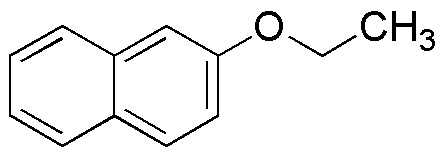2-Ethoxynaphthalene is widely utilized in research focused on:
- Organic Synthesis: This compound serves as a key intermediate in the synthesis of various organic compounds, making it valuable for chemists developing new materials or pharmaceuticals.
- Fluorescent Dyes: It is used in the production of fluorescent dyes, which are essential in biological imaging and analytical chemistry, helping researchers visualize cellular processes.
- Polymer Additives: In the plastics industry, it acts as a plasticizer and stabilizer, enhancing the flexibility and durability of polymers, which is crucial for manufacturing high-performance materials.
- Research in Photochemistry: The compound is utilized in photochemical studies, aiding in the understanding of light-induced chemical reactions, which is important for developing solar energy technologies.
- Flavor and Fragrance Industry: It finds applications in the formulation of fragrances and flavorings, contributing to the production of appealing scents and tastes in consumer products.
Informations générales
Propriétés
Sécurité et réglementation
Applications
2-Ethoxynaphthalene is widely utilized in research focused on:
- Organic Synthesis: This compound serves as a key intermediate in the synthesis of various organic compounds, making it valuable for chemists developing new materials or pharmaceuticals.
- Fluorescent Dyes: It is used in the production of fluorescent dyes, which are essential in biological imaging and analytical chemistry, helping researchers visualize cellular processes.
- Polymer Additives: In the plastics industry, it acts as a plasticizer and stabilizer, enhancing the flexibility and durability of polymers, which is crucial for manufacturing high-performance materials.
- Research in Photochemistry: The compound is utilized in photochemical studies, aiding in the understanding of light-induced chemical reactions, which is important for developing solar energy technologies.
- Flavor and Fragrance Industry: It finds applications in the formulation of fragrances and flavorings, contributing to the production of appealing scents and tastes in consumer products.
Documents
Fiches de données de sécurité (FDS)
La FDS fournit des informations de sécurité complètes sur la manipulation, le stockage et l’élimination du produit.
Spécifications du produit (PS)
Le PS fournit une description complète des propriétés du produit, notamment sa composition chimique, son état physique, sa pureté et les exigences de stockage. Il détaille également les plages de qualité acceptables et les applications prévues du produit.
Certificats d'analyse (COA)
Recherchez des certificats d'analyse (COA) en saisissant le numéro de lot du produit. Les numéros de lot et de lot se trouvent sur l'étiquette d'un produit, après les mots « Lot » ou « Lot de fabrication ».
Numéro de catalogue
Numéro de lot/série
Certificats d'origine (COO)
Ce certificat d'exploitation confirme le pays dans lequel le produit a été fabriqué, et détaille également les matériaux et composants utilisés et s'il est issu de sources naturelles, synthétiques ou autres sources spécifiques. Ce certificat peut être requis pour les douanes, le commerce et la conformité réglementaire.
Numéro de catalogue
Numéro de lot/série
Fiches de données de sécurité (FDS)
La FDS fournit des informations de sécurité complètes sur la manipulation, le stockage et l’élimination du produit.
DownloadSpécifications du produit (PS)
Le PS fournit une description complète des propriétés du produit, notamment sa composition chimique, son état physique, sa pureté et les exigences de stockage. Il détaille également les plages de qualité acceptables et les applications prévues du produit.
DownloadCertificats d'analyse (COA)
Recherchez des certificats d'analyse (COA) en saisissant le numéro de lot du produit. Les numéros de lot et de lot se trouvent sur l'étiquette d'un produit, après les mots « Lot » ou « Lot de fabrication ».
Numéro de catalogue
Numéro de lot/série
Certificats d'origine (COO)
Ce certificat d'exploitation confirme le pays dans lequel le produit a été fabriqué, et détaille également les matériaux et composants utilisés et s'il est issu de sources naturelles, synthétiques ou autres sources spécifiques. Ce certificat peut être requis pour les douanes, le commerce et la conformité réglementaire.

